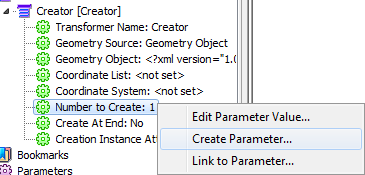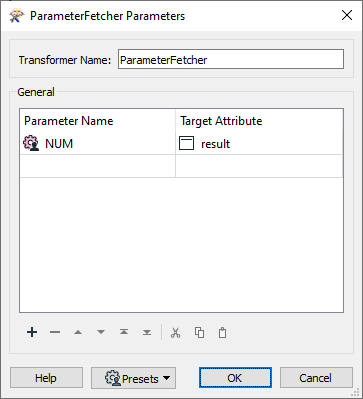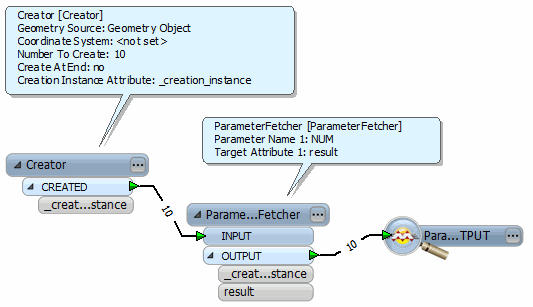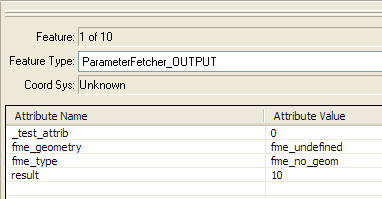Adds an attribute to the feature, supplying it the value of a previously published parameter.
A parameter is a setting that you can pass values into when a translation is run. Parameters usually relate to a setting on a reader or transformer. The ParameterFetcher can be used to copy the value of one or more parameters to a corresponding number of attributes. The number of rows specified in the configuration dialog determine the number of exposed output attributes.
Example
This example describes a single parameter but you can fetch multiple parameters.
The Creator transformer shown below has a published parameter called NUM. To publish this parameter, place the Creator transformer in the workspace. Then right-click on Number to Create and select Create Parameter.

The dialog shows the Published Parameter properties, with the default value changed to 10:

Choose the NUM parameter in the Parameter Name field, and type a Target Attributeresult.

When the workspace is run, the ParameterFetcher fetches the value assigned to the "NUM" parameter and stores it in the "result" attribute. Now the feature has an attribute "result" which holds the value of the "NUM" parameter.

You can see the attribute and its value in the FME Universal Viewer.

Note: For more information on Published Parameters, see the Workbench help topic Adding a Parameter.
Configuration
Parameters
|
Parameter Name |
When the ParameterFetcher is connected, the Parameter Name drop-down list shows the parameters that can be fetched from the workspace. The Parameter Name also exposes FME Parameters and FME Server Parameters. |
|
Target Attribute |
The target attribute is the name of the attribute that will be created. When you select a parameter, this field is automatically filled with an appropriate name (for example, selecting a parameter named WIDTH will automatically name the target attribute _WIDTH). You can use the default name, or type a new name. |
Editing Transformer Parameters
Using a set of menu options, transformer parameters can be assigned by referencing other elements in the workspace. More advanced functions, such as an advanced editor and an arithmetic editor, are also available in some transformers. To access a menu of these options, click  beside the applicable parameter. For more information, see Transformer Parameter Menu Options.
beside the applicable parameter. For more information, see Transformer Parameter Menu Options.
Defining Values
There are several ways to define a value for use in a Transformer. The simplest is to simply type in a value or string, which can include functions of various types such as attribute references, math and string functions, and workspace parameters. There are a number of tools and shortcuts that can assist in constructing values, generally available from the drop-down context menu adjacent to the value field.
Using the Text Editor
The Text Editor provides a convenient way to construct text strings (including regular expressions) from various data sources, such as attributes, parameters, and constants, where the result is used directly inside a parameter.
Using the Arithmetic Editor
The Arithmetic Editor provides a convenient way to construct math expressions from various data sources, such as attributes, parameters, and feature functions, where the result is used directly inside a parameter.
Conditional Values
Set values depending on one or more test conditions that either pass or fail.
Parameter Condition Definition Dialog
Content
Expressions and strings can include a number of functions, characters, parameters, and more.
When setting values - whether entered directly in a parameter or constructed using one of the editors - strings and expressions containing String, Math, Date/Time or FME Feature Functions will have those functions evaluated. Therefore, the names of these functions (in the form @<function_name>) should not be used as literal string values.
| These functions manipulate and format strings. | |
|
Special Characters |
A set of control characters is available in the Text Editor. |
| Math functions are available in both editors. | |
| Date/Time Functions | Date and time functions are available in the Text Editor. |
| These operators are available in the Arithmetic Editor. | |
| These return primarily feature-specific values. | |
| FME and workspace-specific parameters may be used. | |
| Creating and Modifying User Parameters | Create your own editable parameters. |
Dialog Options - Tables
Transformers with table-style parameters have additional tools for populating and manipulating values.
|
Row Reordering
|
Enabled once you have clicked on a row item. Choices include:
|
|
Cut, Copy, and Paste
|
Enabled once you have clicked on a row item. Choices include:
Cut, copy, and paste may be used within a transformer, or between transformers. |
|
Filter
|
Start typing a string, and the matrix will only display rows matching those characters. Searches all columns. This only affects the display of attributes within the transformer - it does not alter which attributes are output. |
|
Import
|
Import populates the table with a set of new attributes read from a dataset. Specific application varies between transformers. |
|
Reset/Refresh
|
Generally resets the table to its initial state, and may provide additional options to remove invalid entries. Behavior varies between transformers. |
Note: Not all tools are available in all transformers.
FME Community
The FME Community is the place for demos, how-tos, articles, FAQs, and more. Get answers to your questions, learn from other users, and suggest, vote, and comment on new features.
Search for samples and information about this transformer on the FME Community.




